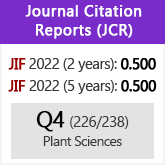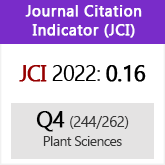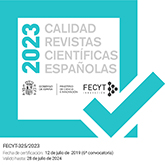A comparative karyological study of Helianthemum (Cistaceae): karyotype size, karyotype symmetry and evolution of chromosome number
DOI:
https://doi.org/10.3989/ajbm.576Keywords:
ChromEvol, comparative cytogenetics, karyotype, plant cytotaxonomyAbstract
In this study we assessed karyotype size and symmetry for a comprehensive taxonomic and geographic representation of Helianthemum and reconstructed chromosome number evolution in the genus. Using root tips, we photographed mitotic metaphase spreads to obtain chromosome number, total haploid (monoploid) length of the chromosome set (THL), karyotype formula, Stebbins’ classification of karyotype asymmetry, interchromosomal coefficient of variation of chromosome length (CVCL) and intrachromosomal mean centromeric asymmetry (MCA) using MATO (Measurement and Analysis Tools). We found that shifts in chromosome number are not a major driver in the evolution of Helianthemum, whose chromosome number evolved at a constant rate of single chromosome gain or loss. Karyotype asymmetry is very low and little variable in all taxonomic categories studied, with a predominance of metacentric and submetacentric small to medium-sized chromosomes about 3 μm at the genus level. However, total karyotype length varies from 16.91 μm to 47.84 μm at the species level, with a cytogenetic signature that is not conserved within subgenera and most sections. Overall, H. subg. Plectolobum shows both the longest and the most symmetrical karyotypes. We hypothesize that the variation in karyotype size in Helianthemum is likely a consequence of chromosome rearrangements that have occurred under selective pressures.
Downloads
References
Albaladejo R.G., Martín-Hernanz S., Reyes-Betancort J.A., Santos-Guerra A., Olangua-Corral M. & Aparicio A. 2021. Reconstruction of the spatio-temporal diversification and ecological niche evolution of Helianthemum (Cistaceae) in the Canary Islands using genotyping-by-sequencing data. Annals of Botany 127: 597-611. https://doi.org/10.1093/aob/mcaa090 PMid:32386290 PMCid:PMC8052925
Altinordu F., Peruzzi L., Yu Y. & He X. 2016. A tool for the analysis of chromosomes: KaryoType. Taxon 65: 586-592. https://doi.org/10.12705/653.9
Aparicio A. & Albaladejo R.G. 2017. On the identity of Helianthemum mathezii and H. pomeridianum (Cistaceae). Anales del Jardín Botánico de Madrid 74: e060. https://doi.org/10.3989/ajbm.2472
Aparicio A, Escudero M., Valdés-Florido A., Pachón M., Rubio E., Albaladejo R.G., Martín-Hernanz S. & Pradillo M. 2019. Karyotype evolution in Helianthemum (Cistaceae): dysploidy, achiasmate meiosis and ecological specialization in H. squamatum, a true gypsophile. Botanical Journal of the Linnean Society 191: 484-501. https://doi.org/10.1093/botlinnean/boz066
Aparicio A., Martín-Hernanz S., Parejo-Farnés C., Arroyo J., Lavergne S., Yeşilyurt E.B., Zang M-L., Rubio E. & Albaladejo R.G. 2017. Phylogenetic reconstruction of the genus Helianthemum (Cistaceae) using plastid and nuclear DNA-sequences: systematic and evolutionary inferences. Taxon: 66: 868-885. https://doi.org/10.12705/664.5
Cacho N.I., McIntyre P.J., Kliebenstein D.J. & Strauss S.Y. 2021. Genome size evolution is associated with climate seasonality and glucosinolates, but not life history, soil nutrients or range size, across a clade of mustards. Annals of Botany 127: 887-902. https://doi.org/10.1093/aob/mcab028 PMid:33675229 PMCid:PMC8225284
Carta A., Bedini G. & Peruzzi L. 2018. Unscrambling phylogenetic effects and ecological determinants of chromosome number in major angiosperm clades. Scientific Reports 8: 14258. https://doi.org/10.1038/s41598-018-32515-x PMid:30250220 PMCid:PMC6155329
Dalgaard V. 1986. Chromosome studies in flowering plants from Macaronesia. Anales del Jardín Botánico de Madrid 43: 83-111.
Elliott T.L., Zedek F., Barrett R.L., Bruhl J.J., Escudero M., Hroudová Z., Joly S., Larridon I., Luceño M., Márquez-Corro J.I., Martín-Bravo S., Muasya A. M., Šmarda P., Thomas W.W., Wilson K.L. & Bureš P. 2022. Chromosome size matters: genome evolution in the cyperid clade. Annals of Botany 130: 999-1014. https://doi.org/10.1093/aob/mcac136 PMid:36342743
Escudero M., Martín-Bravo S., Mayrose I., Fernández-Mazuecos M., Fiz-Palacios O., Hipp AL., Pimentel M., Jiménez-Mejías P., Valcárcel V., Vargas P. & Luceño M. 2014. Karyotypic changes through dysploidy persist longer over evolutionary time than polyploidy changes. PLoS One 9: e85266. https://doi.org/10.1371/journal.pone.0085266 PMid:24416374 PMCid:PMC3887030
Glick L. & Mayrose I. 2014. ChromEvol: assessing the pattern of chromosome number evolution and the inference of chromosome number evolution and the inference of polyploidy along a phylogeny. Molecular Biology and Evolution 31: 1914-1922. https://doi.org/10.1093/molbev/msu122 PMid:24710517
Goldblatt P. & Johnson D.E. 1979. Index to plant chromosome numbers. Missouri Botanical Garden, St. Louis. Website: http://www.tropicos.org/Project/IPCN.
Greilhuber J. & Leitch I.J. 2013. Genome size and the phenotype. In Leitch I.J., Greilhuber J., Doležel J. & Wendel J. (eds.), Plant genome diversity 2: 323-344. Springer-Verlag, Vienna. https://doi.org/10.1007/978-3-7091-1160-4_20
Guerra M. 2012. Cytotaxonomy: The end of childhood. Plant Biosystems 146: 703-710. https://doi.org/10.1080/11263504.2012.717973
Ho L.S.T. & Ane C. 2014. A linear-time algorithm for Gaussian and non-Gaussian trait evolution models. Systematic Biology 63: 397-408. https://doi.org/10.1093/sysbio/syu005 PMid:24500037
Ives A.R. & Garland T. 2010. Phylogenetic logistic regression for binary dependent variables. Systematic Biology 59: 9-26. https://doi.org/10.1093/sysbio/syp074 PMid:20525617
Levan A., Fredga K. & Sandberg A.A. 1964. Nomenclature for centromeric position on chromosomes. Hereditas 52: 201-220. https://doi.org/10.1111/j.1601-5223.1964.tb01953.x
Levin D.A. 2002. The role of chromosomal change in plant evolution. Oxford Series in Ecology and Evolution. Oxford University Press, Oxford and New York.
Lysák M.A., Berr A., Pecinka A., Schmidt R., McBreen K. & Schubert I. 2006. Mechanisms of chromosome number reduction in Arabidopsis thaliana and related Brassicaceae species. Proceedings of the National Academy of Sciences of the United States of North America 103: 5224-5229. https://doi.org/10.1073/pnas.0510791103 PMid:16549785 PMCid:PMC1458822
Martín-Hernanz S., Aparicio A., Fernández-Mazuecos M., Rubio E., Reyes-Betancort A., Santos-Guerra A., Olangua-Corral M. & Albaladejo R.G. 2019. Maximize resolution or minimize error? Using Genotyping-By-Sequencing to investigate the recent diversification of Helianthemum (Cistaceae). Frontiers in Plant Science 10: 1416. https://doi.org/10.3389/fpls.2019.01416 PMid:31781140 PMCid:PMC6859804
Martín-Hernanz S., Velayos M., Albaladejo R.G. & Aparicio A. 2021a. Systematic implications from a robust phylogenetic reconstruction of the genus Helianthemum (Cistaceae) based on genotyping-by-sequencing (GBS) data. Anales del Jardín Botánico de Madrid 78: e113. https://doi.org/10.3989/ajbm.2601
Martín-Hernanz S., Albaladejo R.G., Lavergne S., Rubio E., Grall A. & Aparicio A. 2021b. Biogeographic history and environmental niche evolution in the Palearctic genus Helianthemum (Cistaceae). Molecular Phylogenetics and Evolution 163: 107238. https://doi.org/10.1016/j.ympev.2021.107238 PMid:34197899
Martín-Hernanz S., Albaladejo R.G., Lavergne S., Rubio E., Marín-Rodulfo M., Arroyo J. & Aparicio A. 2023. Strong conservatism of floral morphology during the rapid diversification of the genus Helianthemum (Cistaceae). American Journal of Botany e16155. https://doi.org/10.1002/ajb2.16155 PMid:36912727
Mayrose I., Baker M.S. & Otto S. 2010. Probabilistic models of chromosome number evolution and the inference of polyploidy. Systematic Biology 59: 132-144. https://doi.org/10.1093/sysbio/syp083 PMid:20525626
Paszko B. 2006. A critical review and a new proposal of karyotype asymmetry indices. Plant Systematics and Evolution 58: 39-48. https://doi.org/10.1007/s00606-005-0389-2
Pellicer J., Hidalgo O., Dodsworth S. & Leitch I.J. 2018. Genome size diversity and its impact on the evolution of land plants. Genes 9: 88. https://doi.org/10.3390/genes9020088 PMid:29443885 PMCid:PMC5852584
Pérez-García F. & González-Benito M.E. 2006. Seed germination of five Helianthemum species: effect of temperature and presowing treatments. Journal of Arid Environments 65: 688-693. https://doi.org/10.1016/j.jaridenv.2005.10.008
Peruzzi L. & Eroğlu H. 2013. Karyotype asymmetry: again, how to measure and what to measure? Comparative Cytogenetics 7: 1-9. https://doi.org/10.3897/compcytogen.v7i1.4431 PMid:24260685 PMCid:PMC3833747
Quiner Y. & Gilbert M.G. 2007. Helianthemum. In Wu Z.Y., Raven P.H. & Hong D.Y. (eds.), Flora of China, 13: 70. Science Press, Beijing; Missouri Botanical Garden Press, St. Louis. Website: http://www.eFloras.org [last accessed Oct 2022].
Rice A., Glick L., Abadi S., Einhorn M., Kopelman N.M., Salman-Minkov A., Mayzel J., Chay O. & Mayrose I. 2015. The Chromosome Counts Database (CCDB) - a community resource of plant chromosome numbers. New Phytologist 206: 19-26. https://doi.org/10.1111/nph.13191 PMid:25423910
Schubert I. & Lysák M.A. 2011. Interpretation of karyotype evolution should consider chromosome structural constraints. Trends in Genetics 27: 207-216. https://doi.org/10.1016/j.tig.2011.03.004 PMid:21592609
Snow R. 1963. Alcoholic hydrochloric acid-carmine as a stain for chromosomes in squash preparations. Stain Technology 38: 9-13. https://doi.org/10.3109/10520296309061161 PMid:13989724
Soltis D.E., Soltis P.S., Endress P.K. & Chase M.W. 2005. Phylogeny and evolution of Angiosperms. Sinauer Associates, Washington.
Stace C.A. 2000. Cytology and cytogenetics as a fundamental taxonomic resource for the 20th and 21st centuries. Taxon 49: 451-477. https://doi.org/10.2307/1224344
Stebbins G.L. 1971. Chromosomal evolution in higher plants. Edward Arnold, London.
Tjio J.H. & Levan A. 1950. The use of oxyquinoline in chromosome analysis. Anales de la Estación Experimental Aula Dei 2: 21-64.
Weiss-Schneeweiss H. & Schneeweiss G.M. 2013. Karyotype diversity and evolutionary trends in angiosperms. Genome size and the phenotype. In Leitch I.J., Greilhuber J., Doležel J. & Wendel J. (eds.), Plant genome diversity 2: 209-230. Springer-Verlag, Vienna. https://doi.org/10.1007/978-3-7091-1160-4_13
Zhao Y-Z., Cao R. & Zhu Z-Y. 2000. A new species of Helianthemum. Acta Phytotaxonomica Sinica 38: 294-296.
Published
How to Cite
Issue
Section
License
Copyright (c) 2023 Consejo Superior de Investigaciones Científicas (CSIC)

This work is licensed under a Creative Commons Attribution 4.0 International License.
© CSIC. Manuscripts published in both the printed and online versions of this Journal are the property of Consejo Superior de Investigaciones Científicas, and quoting this source is a requirement for any partial or full reproduction.All contents of this electronic edition, except where otherwise noted, are distributed under a “Creative Commons Attribution 4.0 International” (CC BY 4.0) License. You may read here the basic information and the legal text of the license. The indication of the CC BY 4.0 License must be expressly stated in this way when necessary.
Self-archiving in repositories, personal webpages or similar, of any version other than the published by the Editor, is not allowed.
Funding data
Ministerio de Economía y Competitividad
Grant numbers CGL2014-52459-P, CGL2017-82465-P and PID2020-116355GB-I00
Türkiye Bilimsel ve Teknolojik Araştırma Kurumu
Grant numbers 116Z446
Papanin Institute for Biology of Inland Waters, Russian Academy of Sciences
Grant numbers 121051100099-5

















